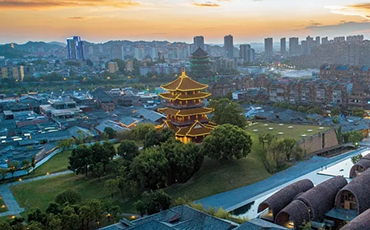



Source: Guihuazhongguo
3.Pieces of the past from the broken pieces of porcelain.
After the Song Dynasty, the “porcelain” continues. In the Ming Dynasty, several pieces of duck-shaped incense burner in the Imperial Kiln Factory in Jingdezhen were fired and molded, broken and buried in the ground for more than 500 years. Now, “aroma duck” to see the light of day, in the Palace Museum exhibition “fire out of the circle”, but also became the Jingdezhen Imperial Kiln Museum's “image spokesman duck”! -- based on the cultural and creative IP image of its prototype “years old duck” once released, it became a netizen.
In fact, the imperial kiln factory buried under the countless pieces of broken porcelain. Hundreds of years later, it is they who leave clues for future generations, and behind them is a story about the Imperial Kiln Factory.
During the Yuan Dynasty, the white first, white is honored, white porcelain then became the emperor's treasured items. Therefore, Jingdezhen white porcelain at that time had an unprecedented development. 1278, Yuan Shizu Kublai in Jingdezhen set up the first official kiln - Liang porcelain bureau, specifically for the Yuan royal family to burn imperial porcelain. It is widely believed that this is the germ of the imperial kiln factory.
Into the Ming Dynasty, in the original Furuang Porcelain Bureau on the basis of the establishment of the Imperial Kiln Factory, the world known as the “Hongwu kilns”. Because of the production of imperial porcelain for the court, the Imperial Kiln Factory has been known as “the essence of the world's good workers, set the world's famous kilns,” known as the highest level of porcelain on behalf of the era, but also the porcelain industry in Jingdezhen to another peak.
So, these deep underground broken pieces of porcelain and where do they come from? Originally, the Imperial Kiln Factory has a strict porcelain selection and management system, often “one hundred shall not be five”, in order to avoid the firing of defective products or selected products into the private sector, need to be broken and buried in the ground. In this standard specification, the title of the Imperial Kiln Factory “product”, must be a fine product. After decades of excavation and protection, has unearthed nearly 20 million pieces of broken porcelain, a pile of yellow earth, a wall of kilns as if to tell the story of the long-silent past and the former glory. Selecting the best of the best, preferring to lack rather than abuse, this is both the prerequisite for craftsmanship, but also the ultimate attitude of demanding perfection. How is the Song people's disconnection not a kind of aesthetics of life?
It is only because of the changes in porcelain that we can prosper from porcelain. Ancient Jingdezhen is being revitalized in a unique way, and innovative stories are constantly being written here. A new landmark of culture and art emerges one after another, upholding the craftsmanship, patience and perseverance of porcelain, and guarding the city's roots and soul in the ever-changing changes.
More detailed can be accessed by:https://mp.weixin.qq.com/s/9w-kXYRmPtXiRVC8LxROrA
Edited and Translated by Tao Guan